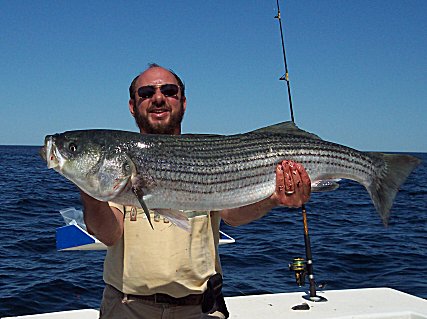Fishing for striped bass has always proven to be a wonderful experience for me, whether from a boat or from the oceanís shorelines. They are vigorous fighters and a real challenge, especially via fly-fishing. Although it has been a few years since I last fished for them, the memories of past trips and catches will always be with me.

In 2007, Stripers Forever compiled 621 surveys, compared to 445 in 2006, to find out what angler sentiments were concerning striped bass and the fishery. They had double digit returns from saltwater anglers from most states from North Carolina to Maine, with more than 150 each from Massachusetts and New Jersey. It is their belief that the 2007 survey has produced a good representative sample of the sentiments from saltwater anglers all along the striped bassís migratory range of the striped bass. A summary of the answers to the 2007 Stripers Forever survey, by question numbers, follows:
2, 3. 70% of respondents fish primarily from boats and about 30% fish mostly from shore. 76% have more than 10 years experience fishing for striped bass.
4. 43% of the anglers indicated that the quality of fishing for striped bass was worse or much worse - the same as for 2005 and 2006 surveys. Only 34% felt that it was improved while the remainder thought it was pretty much unchanged. Those who saw the fishery as improving was down slightly from the 2006 survey (36%). It should be noted that the meaning of "quality" is quite subjective. Some anglers said that the "quality of striped bass fishing had improved greatly" but then said they were catching fewer and/or smaller fish. The indication is that the "quality of fishing" means a lot more to some anglers than either the quantity or size of the fish being caught.
5. As to the size of the striped bass being caught, the majority (57%) reported the average size of the stripers they caught was declining, compared to 22% who felt it was increasing. This is essentially unchanged from the 2006 and 2007 surveys. Numerous comments to the effect that the size of stripers may be seen as running a bit smaller over the last five years, but that the size of todayís average striped bass is very much smaller than it was 10 years ago.
6. The greatest statistical change in 2007 concerned the number of stripers caught per hour. 48% of respondents said they caught fewer fish per hour in 2007. This is the third straight year
that this number has increased. The percentage of anglers who reported catching more stripers dropped to a new low of 17%. Nearly three times as many anglers felt that their hourly catch was dropping as those who thought it was rising.
7. For the fifth consecutive year, the number of Stripers Forever members, whose interest in guided trips has remained in the 58 to 60% range, attribute to the allure of striped bass as a game fish.
8,9,10. 75% of responding anglers felt that a small fish should be allowed for food. 62% felt that it should be offered instead of a larger fish. Many anglers commented that we must stop the killing of so many large stripers and/or that shifting some of the personal harvest to smaller fish made more sense. Many respondents commented that they felt that no bass of any size should be taken until the population has recovered to better levels.
11, 12. Support for a slot limit to take the pressure off of large breeders supported by 74%, the same as the 2005 and 2006 annual surveys. Votes were very evenly split on what the slot size should be. 20 to 26 inch length garnered slightly more votes than 22 to 28 inch lengths for the bass. Many respondents to the survey cited the success of Texas and Florida, which employed both slot limits and game fish status to manage red drum and
snook.
13. The mission of Stripers Forever (to achieve game fish status for striped bass) is frequently challenged by those who claim that Stripers Foreverís real goal is to take, for recreational anglers, all the fish presently caught by the commercial fishing industry, the "quota grab" accusation. The results from every one of Stripers Foreverís five annual member surveys show just how erroneous that interpretation is. A record high of 87% of those surveyed want at least 50% of the commercial catch reserved for conservation and not assigned to increased recreational creel limits. In 2007, 34% want to set aside the entire commercial quota for conservation. That figure is up from 33% in 2006 and 28% in 2005.
14, 15. The popularity of using a stamp to buy out the commercial fishery remained at a high 74% of respondents.
In 2007, Stripers Forever received surveys from a record 56 guides. The number of guides who felt their business was improving was almost identical to those who thought it was declining. Considering the increasingly negative perception of angling quality, the good news is that guides
are still doing well. A thriving guiding business is important evidence of both the social and economic values of recreational fishing for striped bass.
Stripers Forever has received comments from anglers that included: put an end to the commercial fishery for stripers; use more "fish-friendly" tackle, such as circle hooks and adopt management measures to take the pressure off the larger striped bass.
Stripers Forever is a Ďnot for profití corporation, located in the state of Maine. They are a 100% volunteer internet-based organization with the purpose to enhance public fishing for striped bass by categorizing it as a game fish and ending commercial exploitation of this vital recreational species. For additional information on Stripers Forever, you can write to write to: Mr. Ed Mitchell, Secretary, at Stripers Forever, P.O. Box 2781, South Portland, Maine 04116-2781 or go to their website at:
www.stripersforever.org.
|



